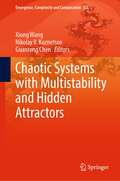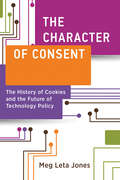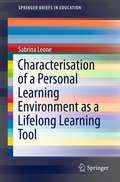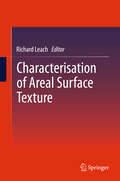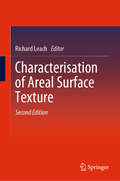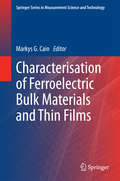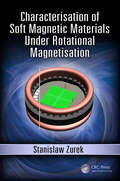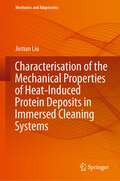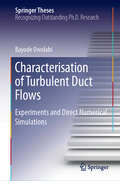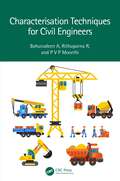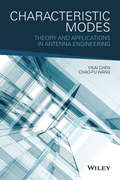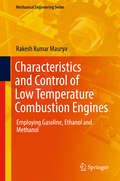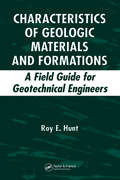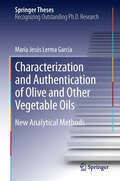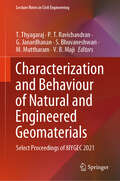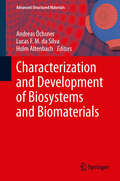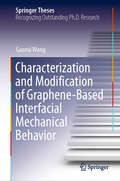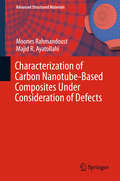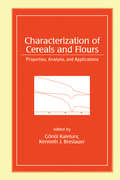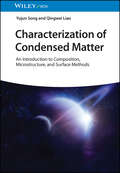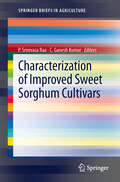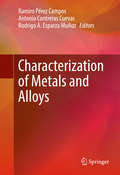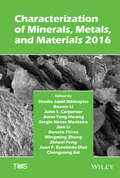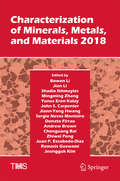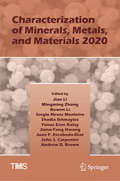- Table View
- List View
Chaotic Systems with Multistability and Hidden Attractors (Emergence, Complexity and Computation #40)
by Xiong Wang Nikolay V. Kuznetsov Guanrong ChenThis book presents a collection of new articles written by world-leading experts and active researchers to present their recent finding and progress in the new area of chaotic systems and dynamics, regarding emerging subjects of unconventional chaotic systems and their complex dynamics.It guide readers directly to the research front of the new scientific studies. This book is unique of its kind in the current literature, presenting broad scientific research topics including multistability and hidden attractors in unconventional chaotic systems, such as chaotic systems without equilibria, with only stable equilibria, with a curve or a surface of equilibria. The book describes many novel phenomena observed from chaotic systems, such as non-Shilnikov type chaos, coexistence of different types of attractors, and spontaneous symmetry breaking in chaotic systems. The book presents state-of-the-art scientific research progress in the field with both theoretical advances and potential applications. This book is suitable for all researchers and professionals in the areas of nonlinear dynamics and complex systems, including research professionals, physicists, applied mathematicians, computer scientists and, in particular, graduate students in related fields.
The Character of Consent: The History of Cookies and the Future of Technology Policy (Information Policy)
by Meg Leta JonesThe rich, untold origin story of the ubiquitous web cookie—what&’s wrong with it, why it&’s being retired, and how we can do better.Consent pop-ups continually ask us to download cookies to our computers, but is this all-too-familiar form of privacy protection effective? No, Meg Leta Jones explains in The Character of Consent, rather than promote functionality, privacy, and decentralization, cookie technology has instead made the internet invasive, limited, and clunky. Good thing, then, that the cookie is set for retirement in 2024. In this eye-opening book, Jones tells the little-known story of this broken consent arrangement, tracing it back to the major transnational conflicts around digital consent over the last twenty-five years. What she finds is that the policy controversy is not, in fact, an information crisis—it&’s an identity crisis.Instead of asking how people consent, Jones asks who exactly is consenting and to what. Packed into those cookie pop-ups, she explains, are three distinct areas of law with three different characters who can consent. Within (mainly European) data protection law, the data subject consents. Within communication privacy law, the user consents. And within consumer protection law, the privacy consumer consents. These areas of law have very different histories, motivations, institutional structures, expertise, and strategies, so consent—and the characters who can consent—plays a unique role in those areas of law. The Character of Consent gives each computer character its due, taking us back to their origin stories within the legal history of computing. By doing so, Jones provides alternative ways of understanding the core issues within the consent dilemma. More importantly, she offers bold new approaches to creating and adopting better tech policies in the future.
Characterisation of a Personal Learning Environment as a Lifelong Learning Tool (SpringerBriefs in Education)
by Sabrina LeoneThis work focuses on the characterization of adult lifelong learners' Personal Learning Environments (PLEs) by implicit and explicit tools of personalization. It aims aims toward creating a system for the development of a learning path for the characterisation of PLE for adult life learners. The synergy of formal and informal learning in the dynamic construction of a lifelong learner's PLE is fully explored, with the recognition that the majority of learning, especially for life long learners, occurs outside traditional learning formats. Specifically, this volume discusses the design, implementation, and validation of the SSW4LL (Social Semantic Web for Lifelong Learners) format, and the the SSW4LL system, built on Moodle 2.0 integrated with an adaptive mechanism (conditional activities) and some tools of Social Semantic Web (Semantic MediaWiki, Diigo and Google+). With thoroughly grounded cases studies, this volume makes the case that these systems are suitable to provide a dynamically personalized learning environment to the lifelong learner. All of these environments are fully discussed and cases made for each as a tool for constructing adult learners' PLEs.
Characterisation of Areal Surface Texture
by Richard LeachThe function of a component part can be profoundly affected by its surface topography. There are many examples in nature of surfaces that have a well-controlled topography to affect their function. Examples include the hydrophobic effect of the lotus leaf, the reduction of fluid drag due to the riblet structure of shark skin, the directional adhesion of the gecko foot and the angular sensitivity of the multi-faceted fly eye. Surface structuring is also being used extensively in modern manufacturing. In this way many properties can be altered, for example optical, tribological, biological and fluidic. Previously, single line (profile) measurements were adequate to control manufacture of surfaces, but as the need to control the functionality of surfaces increases, there is a growing need for three-dimensional (areal) measurement and characterisation techniques. For this reason there has been considerable research, development and standardisation of areal techniques. This book will present the areal framework that is being adopted by the international community. Whereas previous books have concentrated on the measurement aspects, this book concentrates on the characterisation techniques, i.e. how to interpret the measurement data to give the appropriate (functional) information for a given task. The first part of the book presents the characterisation methods and the second part case studies that highlight the use of areal methods in a broad range of subject areas - from automobile manufacture to archaeology. Contents Introduction to Surface Topography The Areal Field Parameters The Areal Feature Parameters Areal Filtering Methods Areal Form Removal Areal Fractal Methods Choosing the Appropriate Parameter Characterisation of Individual Areal Features Multi-Scale Signature of Surface Topography Correlation of Areal Surface Texture Parameters to Solar Cell EfficiencyCharacterisation of Cylinder Liner Honing Textures for Production Control Characterisation of the Mechanical Bond Strength for Copper on Glass Plating Applications Inspection of Laser Structured Cams and Conrods Road Surfaces
Characterisation of Areal Surface Texture
by Richard LeachThis second edition delves into surface topography, exploring its impact on the functionality of various components. Beginning with an introduction to surface topography in Chapter 1, the subsequent chapters delve into the areal field parameters, feature parameters, filtering methods, and form removal techniques, leading into more specialized topics such as fractal-related multiscale geometric characterization and deep learning-based quantification of surface texture. With a focus on characterizing measurement data to glean functional insights, the book presents a comprehensive framework adopted by the international community. Through a diverse array of case studies spanning automotive applications, road surface engineering, additive manufacturing, and precision machining, readers are offered a holistic understanding of how areal techniques are pivotal in modern manufacturing industries. This edition builds upon the foundation laid by its predecessor, integrating evolving standards and additional case studies to provide an updated and comprehensive resource for modern surface engineering.
Characterisation of Ferroelectric Bulk Materials and Thin Films: Solutions For Metrology (Springer Series in Measurement Science and Technology #2)
by Markys G. CainThis book presents a comprehensive review of the most important methods used in the characterisation of piezoelectric, ferroelectric and pyroelectric materials. It covers techniques for the analysis of bulk materials and thick and thin film materials and devices. There is a growing demand by industry to adapt and integrate piezoelectric materials into ever smaller devices and structures. Such applications development requires the joint development of reliable, robust, accurate and - most importantly - relevant and applicable measurement and characterisation methods and models. In the past few years there has been a rapid development of new techniques to model and measure the variety of properties that are deemed important for applications development engineers and scientists. The book has been written by the leaders in the field and many chapters represent established measurement best practice, with a strong emphasis on application of the methods via worked examples and detailed experimental procedural descriptions. Each chapter contains numerous diagrams, images, and measurement data, all of which are fully referenced and indexed. The book is intended to occupy space in the research or technical lab, and will be a valuable and practical resource for students, materials scientists, engineers, and lab technicians.
Characterisation of Soft Magnetic Materials Under Rotational Magnetisation
by Stanislaw ZurekThe book presents practical aspects related to the measurement of rotational power loss in soft magnetic materials. The book furthermore focuses on practical aspects of performing such measurements, the associated difficulties as well as solutions to the most common problems. Numerous practical aspects, hands-on experience, and most commonly encountered pitfalls are heavily discussed in the book. The text begins with introduction to magnetism, then follows with definitions of measurement methods of rotational power loss from physical viewpoint. Two chapters describe and detail the various sensors which can be employed for such measurements as well as all the aspects of designing, making, and using a magnetising apparatus. A synthesis of the likely optimal design of a magnetising apparatus is also given, preceded with the full reasoning based on all the research carried out to date. <P><P>Characterisation of Soft Magnetic Materials Under Rotational Magnetisation serves as an excellent starting point for any student having to perform magnetic measurements under rotational magnetisation, but also under 1D, 2D or 3D excitation. Because the methods, sensors, and apparatus are extensively discussed it will also be a great reference for more senior researchers and experts in the field. There is a whole chapter devoted to analysis of measurement uncertainty. This subject is rarely published for magnetic measurements, which makes it more difficult for all researchers to understand the concepts and methodology used in uncertainty estimation. This chapter not only introduces the whole subject, but also provides multiple step-by-step examples which can be easily followed, from very simple cases to much more complex ones. All equations are presented with full SI units which greatly helps in practical application of the presented methodology. Each chapter is written in such a way that it can be studied on its own, so that the reader can focus only on the specific aspects, as required.
Characterisation of the Mechanical Properties of Heat-Induced Protein Deposits in Immersed Cleaning Systems (Mechanics and Adaptronics)
by Jintian LiuDuring heat treatment in dairy production, the rapid formation of heat-induced fouling deposits on the plant surface leads to reduced efficiency of heat transfer. Therefore, a regular cleaning process is required to soften the heat-induced protein deposits and then remove them from the plant surface. The mechanical property of the deposits is one of the key issues of the cleaning mechanisms since the non-fractured behaviour dominates the deformation of the fouling layer and the failure behaviour has a great impact on the cohesive removal of fouling deposits. Considering the complicated geometry of fouling deposits and their irregular distribution, indentation experiments were carried out on various kinds of protein deposits. The experimental results reveal the significant influence of the thickness of fouling deposits on their mechanical behaviour and the time-dependent nonlinear behaviour of the deposits.Furthermore, heat-induced whey protein gel was used as the model material for fouling deposits and the non-fractured and fracture behaviour was characterized using compression and wire cutting experiments, respectively. The material parameters identified using the inverse finite element method allow the prediction of fracture behaviour under localized external loads and provide a deeper insight into cohesive removal. To investigate the softening effect during caustic washing, tensile experiments were conducted on chemically treated and untreated whey protein gels. Adequate chemical degradation leads to a softer mechanical response and increased stress relaxation, making whey protein gels more flowable and more resistant to tensile deformation. The experimental results provide useful data on the failure behaviour of chemically treated whey protein gels.
Characterisation of Turbulent Duct Flows: Experiments and Direct Numerical Simulations (Springer Theses)
by Bayode OwolabiThis book presents several new findings in the field of turbulent duct flows, which are important for a range of industrial applications. It presents both high-quality experiments and cutting-edge numerical simulations, providing a level of insight and rigour rarely found in PhD theses. The scientific advancements concern the effect of the Earth’s rotation on large duct flows, the experimental confirmation of marginal turbulence in a pressure-driven square duct flow (previously only predicted in simulations), the identification of similar marginal turbulence in wall-driven flows using simulations (for the first time by any means) and, on a separate but related topic, a comprehensive experimental study on the phenomenon of drag reduction via polymer additives in turbulent duct flows. In turn, the work on drag reduction resulted in a correlation that provides a quantitative prediction of drag reduction based on a single, measurable material property of the polymer solution, regardless of the flow geometry or concentration. The first correlation of its kind, it represents an important advancement from both a scientific and practical perspective.
Characterisation Techniques for Civil Engineers
by Bahurudeen A Rithuparna R P V MoorthiThe primary aim of this book is to provide an understanding of the sophisticated, modern characterisation techniques in the domain of civil engineering. It systematically covers physical, chemical, mineralogical and microstructural characterisation, which is imperative to evaluate the construction materials and their performance. It describes tools such as rheometers, thermogravimetric analysers, scanning electron microscopes, X-ray diffractometers and other miscellaneous methods. In each chapter, a detailed scientific background, instrumentation details, working principles, and applications of a specific technique are provided. Features: • Describes rheological and microstructural characterisation testing. • Discusses sophisticated characterisation techniques for construction materials. • Explains the detailed procedure of sample preparation and testing. • Provides detailed descriptions of different parts of the instruments and their purposes. • Includes questions and answers at the end of each chapter. This book is aimed at graduate students and researchers in civil engineering.
Characteristic Modes
by Yikai Chen Chao-Fu WangDescribes how to systematically implement various characteristic mode (CM) theories into designs of practical antenna systems This book examines both theoretical developments of characteristic modes (CMs) and practical developments of CM-based methodologies for a variety of critical antenna designs. The book is divided into six chapters. Chapter 1 provides an introduction and discusses the recent advances of the CM theory and its applications in antenna engineering. Chapter 2 describes the formulation of the characteristic mode theory for perfectly electrically conducting (PEC) bodies and discusses its numerical implementations. Chapter 3 presents the CM theory for PEC structures embedded in multilayered medium and its applications. Chapter 4 covers recent advances in CM theory for dielectric bodies and also their applications. Chapter 5 discusses the CM theory for N-port networks and its applications to the design of antenna arrays. Finally, Chapter 6 discusses the design of platform-integrated antenna systems using characteristic modes. This book features the following: Introduces characteristic mode theories for various electromagnetic structures including PEC bodies, structures in multilayered medium, dielectric bodies, and N-port networks Examines CM applications in electrically small antennas, microstrip patch antennas, dielectric resonator antennas, multiport antennas, antenna arrays, and platform mounted antenna systems Discusses numerical algorithms for the implementation of the characteristic mode theories in computer code Characteristic Modes: Theory and Applications in Antenna Engineering will help antenna researchers, engineers, and students find new solutions for their antenna design challenges.
Characteristics and Control of Low Temperature Combustion Engines: Employing Gasoline, Ethanol and Methanol (Mechanical Engineering Series)
by Rakesh Kumar MauryaThis book deals with novel advanced engine combustion technologies having potential of high fuel conversion efficiency along with ultralow NOx and particulate matter (PM) emissions. It offers insight into advanced combustion modes for efficient utilization of gasoline like fuels. Fundamentals of various advanced low temperature combustion (LTC) systems such as HCCI, PCCI, PPC and RCCI engines and their fuel quality requirements are also discussed. Detailed performance, combustion and emissions characteristics of futuristic engine technologies such as PPC and RCCI employing conventional as well as alternative fuels are analyzed and discussed. Special emphasis is placed on soot particle number emission characterization, high load limiting constraints, and fuel effects on combustion characteristics in LTC engines. For closed loop combustion control of LTC engines, sensors, actuators and control strategies are also discussed. The book should prove useful to a broad audience, including graduate students, researchers, and professionals.
Characteristics of Geologic Materials and Formations: A Field Guide for Geotechnical Engineers
by Roy E. HuntProperly understanding and characterizing geologic materials and formations is vital for making critical engineering decisions. Identifying and classifying rock masses and soil formations allows reasonable estimation of their characteristic properties. Comprising chapters from the second edition of the revered Geotechnical Engineering Investigation
Characterization and Authentication of Olive and Other Vegetable Oils: New Analytical Methods (Springer Theses)
by María Jesús Lerma GarcíaThis thesis presents new methods for the characterization of vegetable oils, with focus in olive oil, according to geographical and botanical origin, genetic variety and other issues influencing product quality. A wide variety of analytical techniques have been employed, such as various chromatographic techniques (different gas and liquid chromatography methods), an electronic nose, infrared spectroscopy and expert-panel evaluation. Several families of minor compounds, with interest as adulteration markers, have been used for method development, including tocopherols, sterols, phenolics, alcohols, proteins and others. Most methods have been enhanced by the application of multivariate chemometrics. The proposed analytical techniques are of interest to investigate fraudulent actions and practices which are detrimental to product quality.
Characterization and Behaviour of Natural and Engineered Geomaterials: Select Proceedings of 8IYGEC 2021 (Lecture Notes in Civil Engineering #420)
by V. B. Maji M. Muttharam T. Thyagaraj P. T. Ravichandran G. Janardhanan S. BhuvaneshwariThis book presents the select proceedings of the 8th Indian Young Geotechnical Engineers Conference (8IYGEC 2021) on the following conference themes: Characterization and Behaviour of Saturated and Unsaturated Geomaterials, Geoenvironmental Engineering, Geotechnical Investigation and Spatial Analysis and Offshore and Marine Geotechnology. The book covers a wide range of topics on characterization and behaviour of natural and engineered geomaterials, which include soil suction characteristics, hydraulic and volume change behaviour of clay liners, collapse behaviour, contaminant transport, phytoremediation, microbial characterization and biochar-amended soil in landfill covers, stabilization of soils, etc. This book can be a valuable reference for academicians and practicing engineers.
Characterization and Development of Biosystems and Biomaterials (Advanced Structured Materials #29)
by Andreas Öchsner Lucas F. Silva Holm AltenbachThis collection of recent activities provides researchers and scientists with the latest trends in characterization and developments of biosystems and biomaterials. Well known experts present their research in materials for drug delivery, dental implants and filling materials, biocompatible membranes, bioactive surface coatings and bio-compatible and eco-sustainable building materials. In The book covers also topics like microorganisms, the human eye, the musculoskeletal system and human body parts.
Characterization and Modification of Graphene-Based Interfacial Mechanical Behavior (Springer Theses)
by Guorui WangThis thesis shares new findings on the interfacial mechanics of graphene-based materials interacting with rigid/soft substrate and with one another. It presents an experimental platform including various loading modes that allow nanoscale deformation of atomically thin films, and a combination of atomic force microscopy (AFM) and Raman spectroscopy that allows both displacement and strain to be precisely measured at microscale. The thesis argues that the rich interfacial behaviors of graphene are dominated by weak van der Waals force, which can be effectively modulated using chemical strategies. The continuum theories are demonstrated to be applicable to nano-mechanics and can be used to predict key parameters such as shear/friction and adhesion. Addressing key interfacial mechanics issues, the findings in thesis not only offer quantitative insights in the novel features of friction and adhesion to be found only at nanoscale, but will also facilitate the deterministic design of high-performance graphene-based nanodevices and nanocomposites.
Characterization of Carbon Nanotube Based Composites under Consideration of Defects (Advanced Structured Materials #39)
by Moones Rahmandoust Majid R. AyatollahiThis volume presents the characterization methods involved with carbon nanotubes and carbon nanotube-based composites, with a more detailed look at computational mechanics approaches, namely the finite element method. Special emphasis is placed on studies that consider the extent to which imperfections in the structure of the nanomaterials affect their mechanical properties. These defects may include random distribution of fibers in the composite structure, as well as atom vacancies, perturbation and doping in the structure of individual carbon nanotubes.
Characterization of Cereals and Flours: Properties, Analysis And Applications
by Gönül Kaletunç and Kenneth J. BreslauerCharacterization of Cereals and Flours is a state-of-the-art reference that details the latest advances to characterize the effects of manufacturing processes and storage conditions on the thermal, mechanical, and structural properties of cereal flours and their products - examining the influence of moisture absorption, storage temperature, baking, and extrusion processing on flour and cereal product texture, shelf-life, and quality. The book discusses the influence of additives on pre- and postprocessed food biopolymers; the development of databases and construction of state diagrams to illustrate the state and function of cereal flours before, during, and after production; and the current techniques in image analysis, light and electron microscopy, and NMR spectroscopy used to analyze the microstructure of cereal products. It also discusses the methods used to optimize processing parameters and formulations to produce end-products with desirable sensory and textural properties; the shelf life of cereal products; and the relationships between the sensory and physical characteristics of cereal foods.
Characterization of Condensed Matter: An Introduction to Composition, Microstructure, and Surface Methods
by Yujun Song Qingwei LiaoCharacterization of Condensed Matter A comprehensive and accessible introduction to the characterization of condensed materials The characterization of condensed materials is a crucial aspect of materials science. The science underlying this area of research and analysis is interdisciplinary, combining electromagnetic spectroscopy, surface and interface testing methods, physiochemical analysis methods, and more. All of this must be brought to bear in order to understand the relationship between microstructures and larger-scale properties of condensed matter. Characterization of Condensed Matter: An Introduction to Composition, Microstructure, and Surface Methods introduces the technologies involved in the characterization of condensed matter and their many applications. It incorporates more than a decades’ experience in teaching a successful undergraduate course in the subject and emphasizes accessibility and continuously reinforced learning. The result is a survey which promises to equip students with both underlying theory and real experimental instances of condensed matter characterization. Characterization of Condensed Matter readers will also find: Detailed treatment of techniques including electromagnetic spectroscopy, X-ray diffraction, X-ray absorption, electron microscopy, surface and element analysis, and more Incorporation of concrete experimental examples for each technique Exercises at the end of each chapter to facilitate understanding Characterization of Condensed Matter is a useful reference for undergraduates and early-career graduate students seeking a foundation and reference for these essential techniques.
Characterization of Improved Sweet Sorghum Cultivars (SpringerBriefs in Agriculture)
by C. Ganesh Kumar P. Srinivasa RaoA number of driving forces, including the soaring global crude oil prices and environmental concerns in both developed and developing nations has triggered a renewed interest in the recent years on the R&D of biofuel crops. In this regard, many countries across the globe are investing heavily in the bioenergy sector for R&D to increase their energy security and reduce their dependence on imported fossil fuels. Currently, most of the biofuel requirement is met by sugarcane in Brazil and corn in the United States, while biodiesel from rapeseed oil in Europe. Sweet sorghum has been identified as a unique biofuel feedstock in India since it is well adapted to Indian agro-climatic conditions and more importantly it does not jeopardize food security at the cost of fuel. Sweet sorghum [Sorghum bicolor (L.) Moench] is considered as a SMART new generation energy crop as it can accumulate sugars in its stalks similar to sugarcane, but without food¬¬-fuel trade-offs and can be cultivated in almost all temperate and tropical climatic conditions and has many other advantages. The grain can be harvested from the panicles at maturity. There is no single publication detailing the agronomic and biochemical traits of tropical sweet sorghum cultivars and hybrid parents. Hence, an attempt is made in this publication- "Characterization of improved sweet sorghum cultivars" to detail the complete description of cultivars. This book serves as a ready reference on the detailed characterization of different improved sweet sorghum genotypes following the PPVFRA guidelines for the researchers, entrepreneurs, farmers and other stakeholders to identify the available sweet sorghum cultivars and understand their yield potential in tropics.
Characterization of Metals and Alloys (Materials Science Forum Ser. #Vol. 755)
by Ramiro Pérez Campos Antonio Contreras Cuevas Rodrigo A. Esparza MuñozThisbook covers various aspects of characterization of materials in the areas ofmetals, alloys, steels, welding, nanomaterials, intermetallic, and surfacecoatings. These materials are obtained by different methods and techniques likespray, mechanical milling, sol-gel, casting, biosynthesis, and chemicalreduction among others. Some of these materials are classified according toapplication such as materials for medical application, materials for industrialapplications, materials used in the oil industry and materials used likecoatings. The authors provide a comprehensive overview of structuralcharacterization techniques including scanning electron microscopy (SEM), X-raydiffraction (XRD), transmission electron microscopy (TEM), Raman spectroscopy, imageanalysis, finite element method (FEM), optical microscopy (OM), energy dispersive spectroscopy (EDS), Fourier transform infrared spectroscopy(FTIR), differential thermal analysis (DTA), differential scanning calorimetry(DSC), ultraviolet-visible spectroscopy (UV-Vis), infrared photo-thermalradiometry (IPTR), electrochemical impedance spectroscopy (EIS), thermogravimetryanalysis (TGA), thermo luminescence (TL), photoluminescence (PL), high resolutiontransmission electron microscopy (HRTEM), and radio frequency (RF). The bookincludes theoretical models and illustrations of characterization properties--bothstructural and chemical.
Characterization of Minerals, Metals, and Materials 2016
by Chengguang Bai Shadia Ikhmayies Donato Firrao John S. Carpenter Sergio Neves Monteiro Jiann-Yang Hwang Mingming Zhang Bowen Li Jian Li J. Pablo Escobedo-Diaz Zhiwei PengCharacterization is an important and fundamental step in material research before and after processing. This bookfocuses on the characterization of minerals, metals, and materials as well as the application of characterization results on the processing of these materials. It is a highly authoritative collection of articles written by experts from around the world. The articles center on materials characterization, extraction, processing, corrosion, welding, solidification, and method development. In addition, articles focus on clays, ceramics, composites, ferrous metals, non-ferrous metals, minerals, electronic, magnetic, environmental, advanced and soft materials. This book will serve the dual purpose of furnishing a broad introduction of the field to novices while simultaneously serving to keep subject matter experts up-to-date.
Characterization of Minerals, Metals, and Materials 2018 (The Minerals, Metals & Materials Series)
by Andrew Brown Jian Li Jiann-Yang Hwang Shadia Ikhmayies Donato Firrao John S. Carpenter Sergio Neves Monteiro Mingming Zhang Bowen Li Zhiwei Peng Juan P. Escobedo-Diaz Chenguang Bai Yunus Eren Kalay Ramasis Goswami Jeongguk KimThis collection gives broad and up-to-date results in the research and development of materials characterization and processing. Coverage is well-rounded from minerals, metals, and materials characterization and developments in extraction to the fabrication and performance of materials. In addition, topics as varied as structural steels to electronic materials to plant-based composites are explored. The latest research presented in this wide area make this book both timely and relevant to the materials science field as a whole. The book explores scientific processes to characterize materials using modern technologies, and focuses on the interrelationships and interdependence among processing, structure, properties, and performance of materials. Topics covered include ferrous materials, non-ferrous materials, minerals, ceramics, clays, soft materials, method development, processing, corrosion, welding, solidification, composites, extraction, powders, nanomaterials, advanced materials, and several others.
Characterization of Minerals, Metals, and Materials 2020 (The Minerals, Metals & Materials Series)
by Jian Li Jiann-Yang Hwang Shadia Ikhmayies John S. Carpenter Sergio Neves Monteiro Mingming Zhang Bowen Li Juan P. Escobedo-Diaz Yunus Eren Kalay Andrew D. BrownThis collection gives broad and up-to-date results in the research and development of materials characterization and processing. Topics covered include advanced characterization methods, minerals, mechanical properties, coatings, polymers and composites, corrosion, welding, magnetic materials, and electronic materials. The book explores scientific processes to characterize materials using modern technologies, and focuses on the interrelationships and interdependence among processing, structure, properties, and performance of materials.
